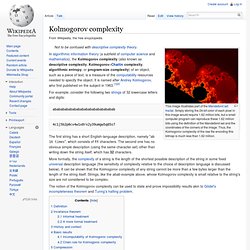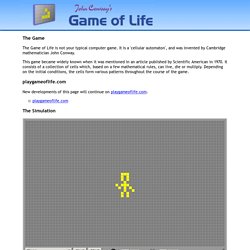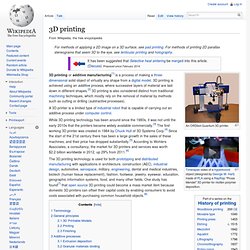

Kolmogorov complexity. In algorithmic information theory (a subfield of computer science and mathematics), the Kolmogorov complexity (also known as descriptive complexity, Kolmogorov–Chaitin complexity, algorithmic entropy, or program-size complexity) of an object, such as a piece of text, is a measure of the computability resources needed to specify the object.

It is named after Andrey Kolmogorov, who first published on the subject in 1963.[1][2] abababababababababababababababab 4c1j5b2p0cv4w1x8rx2y39umgw5q85s7 The first string has a short English-language description, namely "ab 16 times", which consists of 11 characters. The second one has no obvious simple description (using the same character set) other than writing down the string itself, which has 32 characters. The notion of the Kolmogorov complexity can be used to state and prove impossibility results akin to Gödel's incompleteness theorem and Turing's halting problem.
Definition[edit] Any string s has at least one description, namely the program: ∀s. ∀s. DIY Drones Amateur UAV & Drone Autopilot Kits from Build Your Own Drone in the UK & Europe. List of emerging technologies. Holography. Two photographs of a single hologram taken from different viewpoints The holographic recording itself is not an image; it consists of an apparently random structure of either varying intensity, density or profile.

Overview and history[edit] The Hungarian-British physicist Dennis Gabor (in Hungarian: Gábor Dénes),[1][2] was awarded the Nobel Prize in Physics in 1971 "for his invention and development of the holographic method".[3] His work, done in the late 1940s, built on pioneering work in the field of X-ray microscopy by other scientists including Mieczysław Wolfke in 1920 and WL Bragg in 1939.[4] The discovery was an unexpected result of research into improving electron microscopes at the British Thomson-Houston (BTH) Company in Rugby, England, and the company filed a patent in December 1947 (patent GB685286).
Several types of holograms can be made. Holograms can also be used to store, retrieve, and process information optically.[18] How holography works[edit] John Conway's Game of Life. The Game The Game of Life is not your typical computer game.

It is a 'cellular automaton', and was invented by Cambridge mathematician John Conway. This game became widely known when it was mentioned in an article published by Scientific American in 1970. It consists of a collection of cells which, based on a few mathematical rules, can live, die or multiply. Depending on the initial conditions, the cells form various patterns throughout the course of the game. playgameoflife.com New developments of this page will continue on playgameoflife.com. playgameoflife.com The Simulation Figure from the XKCD RIP John Conway comic. The Rules For a space that is 'populated': Each cell with one or no neighbors dies, as if by solitude. Each cell with four or more neighbors dies, as if by overpopulation. Rube Goldberg machine. A Rube Goldberg machine, contraption, invention, device, or apparatus is a deliberately over-engineered or overdone machine that performs a very simple task in a very complicated fashion, usually including a chain reaction.

The expression is named after American cartoonist and inventor Rube Goldberg (1883–1970). Over the years, the expression has expanded to mean any confusing or complicated system. For example, news headlines include "Is Rep. Bill Thomas the Rube Goldberg of Legislative Reform? "[1] and "Retirement 'insurance' as a Rube Goldberg machine".[2] Origin[edit] Professor Butts and the Self-Operating Napkin In 1931, the Merriam–Webster dictionary adopted the word "Rube Goldberg" as an adjective defined as accomplishing something simple through complicated means.[4] Similar expressions worldwide[edit] Professional artists[edit] Peter Fischli & David Weiss, Swiss artists known for their art installation movie Der Lauf der Dinge (The Way Things Go, 1987).
3D printing. An ORDbot Quantum 3D printer. 3D printing or additive manufacturing[1] is a process of making a three-dimensional solid object of virtually any shape from a digital model. 3D printing is achieved using an additive process, where successive layers of material are laid down in different shapes.[2] 3D printing is also considered distinct from traditional machining techniques, which mostly rely on the removal of material by methods such as cutting or drilling (subtractive processes).

A 3D printer is a limited type of industrial robot that is capable of carrying out an additive process under computer control. The 3D printing technology is used for both prototyping and distributed manufacturing with applications in architecture, construction (AEC), industrial design, automotive, aerospace, military, engineering, dental and medical industries, biotech (human tissue replacement), fashion, footwear, jewelry, eyewear, education, geographic information systems, food, and many other fields. Arduino - HomePage. Feature creep. Feature creep, creeping featurism or featuritis is the ongoing expansion or addition of new features in a product, such as in computer software.[1] Extra features go beyond the basic function of the product and so can result in over-complication rather than simple design.

Causes[edit] The most common cause of feature creep is the desire to provide the consumer with a more useful or desirable product, in order to increase sales or distribution. However, once the product reaches the point at which it does everything that it is designed to do, the manufacturer is left with the choice of adding unneeded functions, sometimes at the cost of efficiency, or sticking with the old version, at the cost of a perceived lack of improvement.
Another major cause of feature creep might be a compromise from a committee which decides to implement multiple, different viewpoints in the same product. Marketing considerations: Product life cycle and the competition impetus[edit]